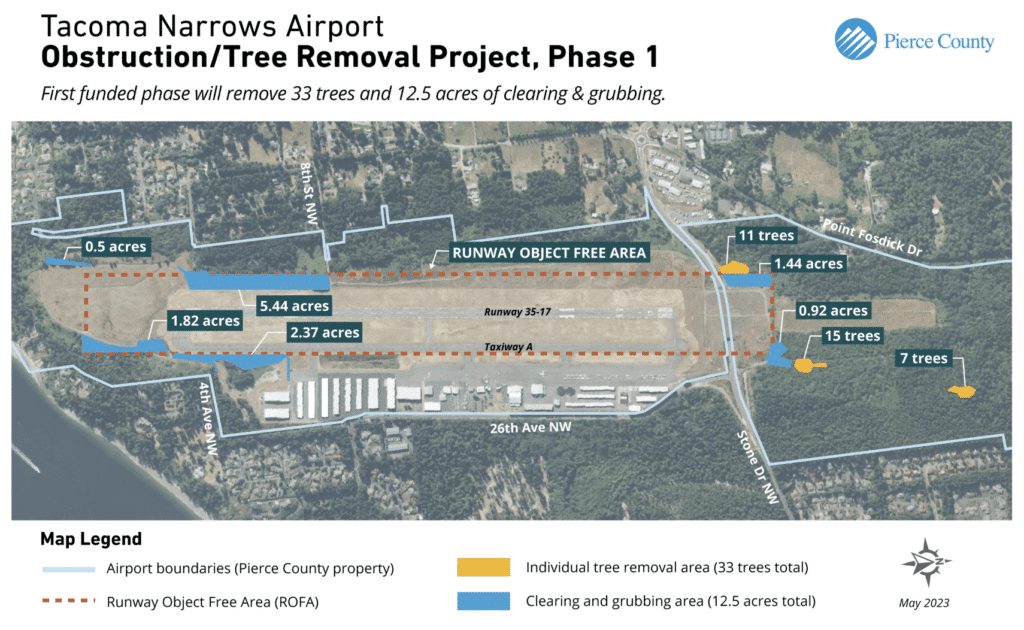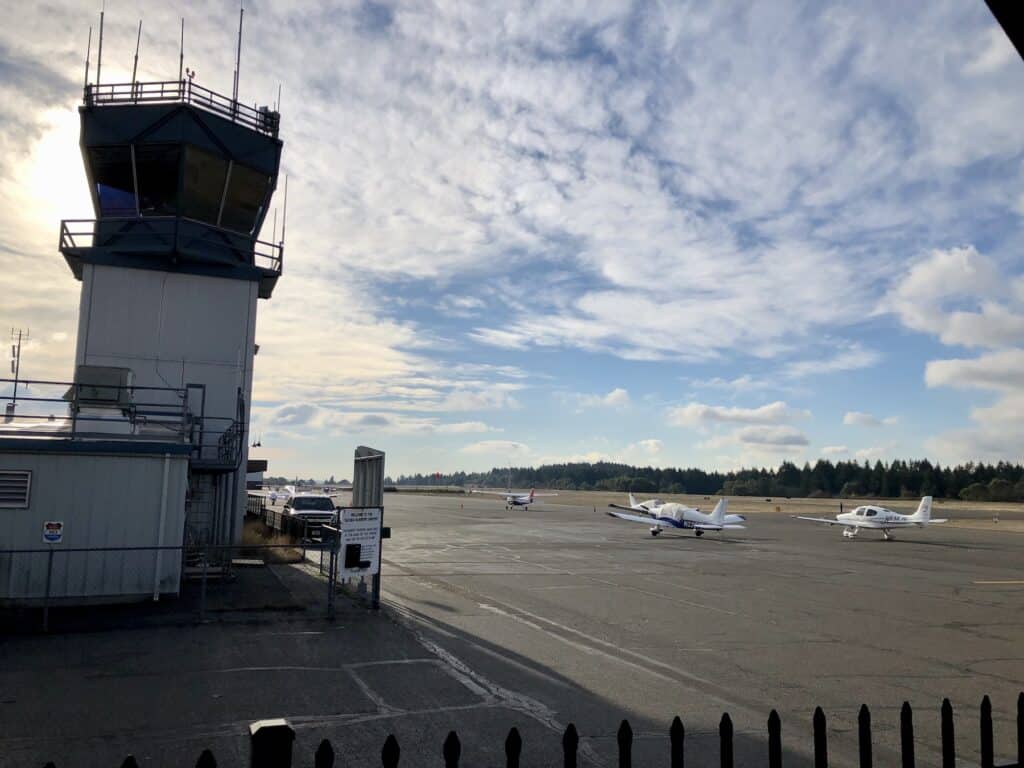Community Environment Government
County delineates first phase of airport tree removal
The first phase of tree cutting at Tacoma Narrows Airport will take down only a fraction of the total number designated for removal.
Neighbors of the Pierce County-owned facility received a postcard recently describing Phase 1 of the project. The county sent the cards in late May to about 1,100 residents near the airport, according to Akiko Oda, spokeswoman for the Planning and Public Works Department.
Removing 33 trees, clearing 12.5 acres
The mailing states that from next fall through late spring 2024, the county will remove 33 individual trees obstructing or soon to be obstructing airspace; and clear 12.5 acres. Crews will log selectively when possible to retain surrounding vegetation. They’ll clear and grub where trees grow so densely that it’s not practical to harvest them individually.
A 2019 survey of 18,000 trees determined that 51.7 acres of the 568-acre airport need to be cleared and 2,055 trees selectively logged because they’re a hazard to navigation. The first phase is limited by available funding, according to the FAA.

All of the acreage to be cleared falls within the object-free area of the airport, said Natalie Wimberly, who chairs the airport’s advisory commission. An object-free area, by FAA definition, is “an area on the ground centered on a runway, taxiway or taxilane centerline provided to enhance the safety of aircraft operations by having the area free of objects, except for objects that need to be located in the OFA for air navigation or aircraft ground maneuvering purposes.”
The trees are at both ends of the runway, with the majority on the north end, Wimberly said. A map on the postcard shows that in the initial phase, 10.1 acres at the south end will be cleared and 2.4 acres at the north end, along with the 33 individual trees (see map). The plan doesn’t specify the number of trees growing in the areas to be cleared.
Future phases to be determined later
There are no additional obstruction studies planned by the county, Wimberly said. Phase 2 is still several years out.
“The FAA, Pierce County and airport staff have an obligation to the safety of flight and airport operations, but do take, very seriously, environmental impacts and concerns of our community,” she said.
FAA requirements for future phases are not yet clear, Oda said.
“We do know that we will not exceed 2,055 trees in total and 51.7 acres of clearing and grubbing,” she said. “Additional obstruction removal will be determined after Phase 1 is complete and is subject to safety-of-flight requirements and available funding in 2026-2027.”
Denson reiterated that the first batch of trees to be cut are those that present the greatest danger to the flight path, and that the 51.7 acres of clearing and 2,055 individual trees is a worst-case scenario.
Denson happy with phased approach
“Hopefully they’ll take a look at each phase and pare down what is absolutely necessary to remove,” said Denson, whose District 7 includes Gig Harbor and Key peninsulas, Ruston and part of North Tacoma.
“I’m happy it’s been pared down for Phase 1. I think everyone appreciates that we need a safe airport. The FAA has identified these as being the most dangerous trees right now. I’m comfortable with that. I’m happy they’re not removing all the trees at once. In a couple years the FAA will look at the situation and we can discuss the next-phase numbers with them.
“There’s always an opportunity for continued conversation about this, which is really good. Because once those trees are gone, they’re gone. I’m glad we’re taking our time and looking at each phase.”
Topping not a preferred option
Denson asked the FAA whether topping trees would be an option to felling them. That is an option, but the FAA will only pay to remove a tree once, and topping a tree is treated the same as a removal. Most airports choose to remove trees instead of topping to eliminate ongoing maintenance costs.
Also, it said, arborists recommend against topping, which leaves trees susceptible to fungus and insects. If trees get sick and die after topping, the airport is responsible for their removal.
And birds tend to root and nest in topped trees. That makes them more likely to be struck by a plane, which is nearly always fatal to the animal and unsafe for the plane.
The airport received FAA Airport Improvement Program (AIP) grants to complete a master plan update in 2016. That update and an airport landside planning study in 2019 identified the tree cutting and other projects to improve safety and comply with Federal Aviation Administration standards.
Work that will take place in 2024 includes shifting the main taxiway 50 feet to the east so it’s an FAA-required 400 feet from the runway and moving a stormwater pond that’s in the way; rerouting another taxiway to divert direct access to the runway, per FAA regulations; and adding more security fencing to keep wildlife out of operating areas.
These projects do not include a runway extension, and do not affect the type or size of aircraft that currently operate at the airport.
The funding obligated the county to comply with all FAA regulations, said Airport Manager Rob Propst. Otherwise, the FAA could withhold future grants.
Environmental assessment
The FAA conducted an environmental assessment for the proposed projects, including tree removal. The assessment included a public comment period that ran from Feb. 16, 2022, through March 17, 2022.
Many of the 26 people who remarked on a draft environmental assessment worried that removing the trees would kill wildlife, destroy habitat, harm air quality, and result in the loss of rural character, shade and beauty. Increased noise was another major concern. After reviewing and responding to the public comments, the FAA issued a finding of no significant impact in April 2022.
The airport is pursuing a $9 million FAA grant for fiscal year 2023 for the airport improvements and tree removal, said Propst. Removing all the trees would cost an estimated $4.6 million, with the FAA funding 90%.
Planning and Public Works staff will meet with the FAA this week to discuss contractor bids for Phase 1 of the project, Oda said.


